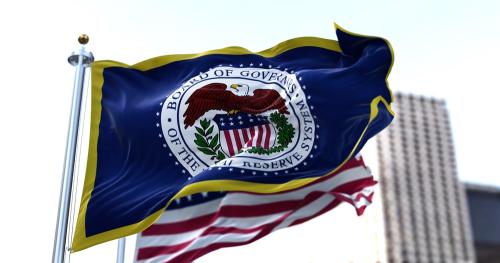In testimony before the House Financial Services Committee, Alice Rivlin addresses proposed bills to restrict the Federal Reserve’s policy-making actions.
Chairman Paul and Ranking Member Clay:
I am happy to have this opportunity to testify before the subcommittee as you consider a diverse set of bills designed to alter the role, structure, or functioning of the Federal Reserve. I will focus my brief remarks this morning on the importance of preserving the Federal Reserve’s dual mandate to target both maximum employment and price stability. I believe that the dual mandate has served the United States well, and that it would be a mistake to restrict the Fed’s policy actions to fostering stable prices alone, as proposed by Mr. Brady in HR 4180 and Mr. Pence in HR 245.
I would like to make clear at the outset that I believe a strong, independent central bank is essential to keeping the United States economy functioning as productively as possible without unnecessarily costly swings in economic activity. Market capitalism has proven its ability to produce goods and services efficiently and deliver a rising standard of living, but it is prone to instability. Monetary policy, along with fiscal policy, can help moderate booms and busts, although it cannot erase the business cycle. Leaning against the economic winds, however, often involves unpopular actions, such as raising interest rates as a boom gathers excessive steam. There is always huge uncertainty about how the complex machinery of the economy is actually working and what results monetary policy can expect to achieve. Nevertheless, chances of successful monetary policy are highest when these difficult decisions are delegated to a group of qualified, experienced people, who are as insulated as possible from political pressures to please the public in the short run. Without a strong independent central bank functioning to mitigate economic and financial instability, the United States would have a weaker, far more chaotic economy and lose its leadership position in the global economy.
The objective of economic policy—including monetary policy—should be a rising standard of living for most people over the long run. That means maximizing sustainable economic growth and productive employment. Controlling inflation is a crucial element of the larger objective because high and, especially, rising inflation is a serious threat to sustained growth. The expectation of rising prices distorts both consumer and investor behavior and can even turn into a destructive, self perpetuating hyperinflation. Hence, an essential prerequisite for steadily increasing prosperity is a widespread, firmly anchored expectation that reasonably stable prices will prevail in the future.
Hence, I believe the dual mandate is simply a reflection of what average citizens ought to expect their central bank to do: Let the economy create as many jobs as possible, but don’t let inflation interfere with that job growth. Economists translate that common sense exhortation into a monetary policy aimed at keeping the economy as close as possible to its long-run potential growth, without seriously overshooting in either direction. This idea is encapsulated in Pro. John Taylor’s famous rule that prescribes easing or tightening when observed economic growth appears to be deviating from potential in either direction.
The problem for the Fed’s decision makers is that potential growth is not observable, because it depends on trends in productivity growth, which can shift unexpectedly. In the stagflation of the 1970s, hindsight indicates that monetary policy makers overestimated potential growth and did not tighten soon enough to avoid the acceleration of inflation at the end of the decade. The aggressive tightening of monetary policy in 1979—and the deep recession of the early 1980s that followed—might have been mitigated if the Fed had acted more aggressively sooner. In the 1990s, when I was at the Fed, we faced a happier version of the same uncertainty. Unemployment had fallen to levels that past experience indicated could trigger inflation, but inflation was actually falling. We held off tightening on the presumption, which proved correct, that accelerating productivity growth had raised potential growth and reduced the risk of inflation.
Partly thanks to the Fed, the late 1990s illustrated the benefits of very tight labor markets without significant inflation. Marginal workers found jobs, acquired skills, and work experience, while firms had strong incentives to retain workers by training them, using their skills more effectively, and moving them into better paid jobs. We also had appropriately tightening fiscal policy that balanced the budget—a feat far easier to accomplish in a strongly growing economy. The sooner we get back to those conditions, the better!
But the late 1990s also illustrated the inadequacy of the Fed’s toolkit in response to asset price bubbles. Some have criticized the Fed for not tightening monetary policy in response to “irrational exuberance” in the dotcom stock bubble of the late 1990s. But raising interest rates enough to prick that bubble sooner would probably have tipped the economy into recession, punishing workers and companies across the country for no good reason. Influencing the federal funds rate through open market operations is simply not an effective way of calming an asset price bubble. That lesson had to be learned again in the far more dangerous housing price bubble that gathered steam in the 2000’s and whose bursting precipitated the financial crash of 2008 and the ensuing Great Recession. Arguably the Fed kept interest rates too low too long, exacerbating the housing bubble, but interest rates were not the main cause of the catastrophe, nor could monetary policy alone have averted it. Among multiple culprits, I fault the Fed for not using its regulatory powers, in conjunction with other regulators, to raise underwriting standards for mortgage lenders, punish predatory lending, and rein in excessive financial leverage. While we should not have needed a catastrophe to learn this lesson, the Dodd-Frank Act now gives the Fed and the Financial Stability Oversight Council (FSOC) responsibility for financial stability and new tools with which to help achieve it.
The dual mandate is not inconsistent with strong emphasis on controlling inflation when appropriate or even with an explicit target for inflation. Indeed, last January the Fed confirmed a long run inflation goal of two percent. Operating under the dual mandate the Fed has successfully controlled inflation for three decades. To change the language of the law to imply that the Fed’s only concern should be inflation would send a misleading signal to a public rightly concerned with jobs and growth, as well as inflation. It would imply that inflation is serious current threat to American prosperity, which seems to me unwarranted.
Exclusive attention to inflation and firmly announced inflation targets served central banks well in the last century, especially in small open economies that could ill afford importing inflation through swings in their currencies. But it would be ludicrous for the United States to put sole emphasis on inflation now, when we have slack labor markets and substantial excess capacity in most economic sectors. Some have urged the Fed to try to create more inflation in the current situation, but that would be hard to achieve, even if it were desirable. Our economy is far less inflation prone than it was in the 1970s. It is more flexible, less dependent on energy prices, has easy access to more sources of supply in the face of domestic prices increases, no longer has wages dominated by multi-year indexed labor contracts, and benefits from expectations that reflect 30 years of reasonably stable prices. That recent oil price shocks have had so little effect on core inflation is evidence of lower inflation risk than the 1970s.
What we need now is a continuation of accommodative monetary policy plus fiscal policy that combines additional investment in long run growth and jobs with credible long-run action to stabilize the debt. In short, monetary policy as executed by the Fed under the dual mandate has a positive track record and is currently appropriate. I would urge the Congress not to tamper with legislative language that has served us well.
Thank you for your attention. I would be happy to answer questions.



Commentary
TestimonyThe Case for Preserving the Federal Reserve’s Dual Mandate
May 8, 2012